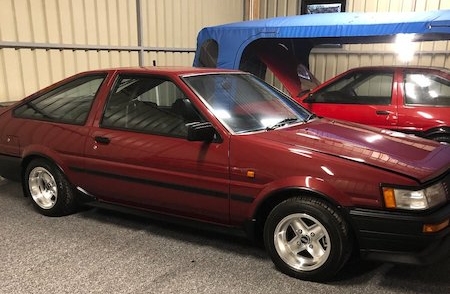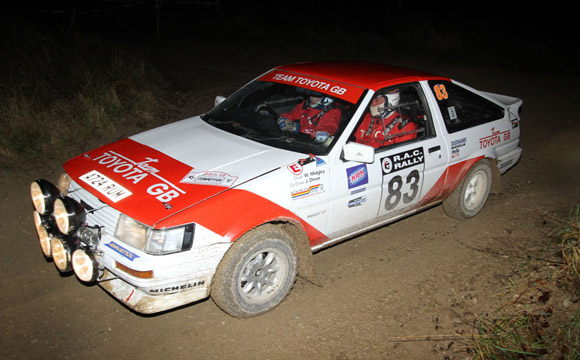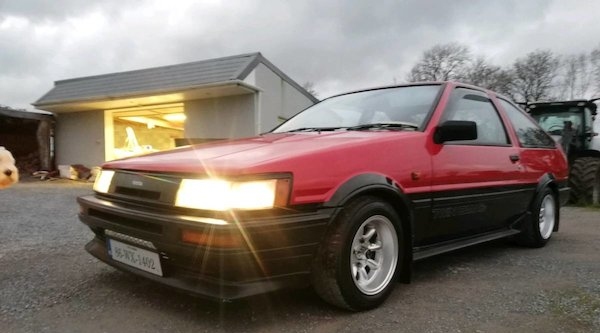
Ah, St. Patrick’s Day, the most hackneyed of holidays, that magical time of year when Americans tack up caricatures of supposed Irish culture like shamrocks and leprechauns and guzzle offensively named cocktails. Why not switch it up and salute authentically Irish things, like immersion water heaters, rashers bacon, or the Toyota AE86.

You must be thinking that, having been manufactured on Honshu and not Eire, the Hachiroku is a Japanese car. However, it’s beloved by car enthusiasts around the globe, with a legend so massive that it defies constraint to a single region. And as with poetry or whiskey, the Irish have a peculiar passion for the AE86 that is uniquely their own, and have cultivated a native aesthetic around their cherished automobile that is highly specific, with a style code so strict that it borders on orthodoxy.
To understand Ireland’s long-standing devotion to the AE86, one needs to understand its origins. Though long a favorite among the grassroots crowd in Japan and beyond thanks to its reliability and tossable rear-wheel-drive platform, the AE86 found its greatest success in professional motorsport not in its motherland, but in Europe.

Thanks to its near-total dominance in small-displacement categories, the AE86 claimed overall manufacturer’s titles in both the European and British Touring Car Championships throughout the mid-1980s, prevailing over big-engined rivals from Ford, Rover and BMW. The Corolla proved to be a formidable Group A contender in WRC rallying as well, where a Japanese-entered AE86 took a class win in the grueling RAC Rally in Wales in 1984.

This legacy of motorsport success resonated strongly throughout Europe, but especially in Ireland, where the massively popular (and loosely regulated) stage rally scene meshed nicely with the AE86’s toughness and intuitive handling. Amateur rallyists adopted the Hachiroku en masse, and before long the car virtually became synonymous with rallying itself in Ireland.
The touring car and rally success of the AE86 formed the foundation for what has become Ireland’s ongoing love affair with the car known simply and affectionately as “the Twincam,” as well as for its sacrosanct “Irish-spec” (or sometimes “UK-spec”) look.

Yes, sacrosanct. The AE86 was only sold in the UK and Ireland under the moniker Toyota Corolla GT Coupe. Like Japan and the US, two body styles were offered, a hatchback and a notchback, the latter of which was known locally as a “booter.” Unlike the US, however, the fixed-headlight “Levin” presentation was the only fascia available. More often than not, though, the prototypical Irish-spec cars’ squarish visage is hidden behind a set of massive Cibie driving lights.

Almost without exception, they feature stock fender arches — no wide flares here, just a clean narrow body usually sitting atop a set of 13-inch Minilites or 14-inch Revolutions. Right height is lowered, but just a wee bit. The Twincam’s eponymous piece of kit, the immortal 4A-GE, is usually stock, and always attached to a Janspeed exhaust.

And that’s it. Those are the rules. Very minor cosmetic tweaks are permissible, but make any modifications that deviate substantially from the template and you have a car that may be unique, but it damn sure ain’t Irish-spec.
The Irish-spec Corolla scene is guarded closely by a devout group of enthusiasts who operate in semi-secrecy. Group drives are usually rural affairs held in remote areas, organized with a minimum of publicity. In a nod to the Twincam’s local rally heritage, these “messings” are usually marked by large amounts of tail-out hi-jinks. Somehow, though, despite being slid around in Ireland’s pervasively wet countryside, one seldom finds a speck of mud on the flanks of an Irish-spec Corolla; spoiled JNC owners in sunny southern California could take a lesson from this fastidiousness.
In a way, this clandestine hooliganism bonds the Irish-spec scene to the early drift culture of the AE86’s native homeland in Japan, before sponsors and glitz tainted its purity. Not coincidentally, there’s also a mainstream drift culture in Ireland that more closely resembles that found in the rest of the world, but chasm between that crowd and the defenders of the Irish-spec faith is as wide as the Irish Sea.

With the global spread of car culture being what is, the prevailing Japanese style has also had a huge influence on Ireland as well. According to editor-at-large Ricky Silverio, Ireland also possesses some of the most faithful Japanese-style Hachiroku homages in the world, attributable to the Irish’s preservationist culture. In fact, he says, such is the reverence for the AE86 that there are a number of actual Japanese drift cars that have been imported to Ireland and kept as-is there.

The steady rise of Hachiroku values has not left Ireland’s native AE86 scene untouched, and coupled with increasingly intrusive traffic laws, the proper enjoyment of Irish-spec Corollas is not only an expensive proposition (here’s a clean one selling for £27,000, or just under $36,000 USD), but possibly an endangered one as well.
Nevertheless, the Twincam community maintains the purity and spirit of their distinctive take on 86 appreciation with steadfast devotion, and perhaps, in the words of Irish playwright Sean O’Casey, with “a lament in one ear, maybe, but always a song in the other.”
Images courtesy of Toyota UK, Cusco, DoneDeal.









Janspeed kit available from Demon Tweeks (a UK speedshop).
Great article and Happy St. Patricks day.
Caed Mille Failte ! Sorry for the Latin script but my computer doesn’t have provision for the Gaelic alphabet. Happy as authentic a St Patricks day as you may find. Now to find some real Soda Bread !
The “notchback” as you call it was never sold in the UK or Ireland, only the hatch.